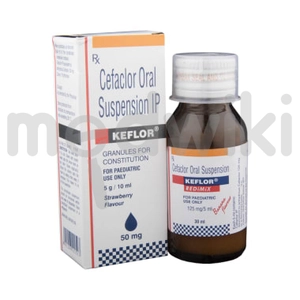keflor
Introduction to Keflor
Keflor is a widely used antibiotic medication designed to combat bacterial infections. It belongs to the class of cephalosporin antibiotics and is known for its effectiveness in treating a variety of bacterial infections. Keflor is available in multiple forms, including tablets, capsules, and oral suspension (syrup), making it versatile for different age groups and patient needs. It works by inhibiting the growth of bacteria, thereby helping the immune system to eliminate the infection. Keflor is commonly prescribed for infections of the respiratory tract, skin, ears, and urinary tract, among others.
Composition of Keflor
The active ingredient in Keflor is Cefaclor, which is a second-generation cephalosporin antibiotic. Cefaclor works by disrupting the synthesis of the bacterial cell wall, leading to cell lysis and death of the bacteria. This mechanism of action makes Cefaclor effective against a broad spectrum of Gram-positive and Gram-negative bacteria. The typical dosage for Keflor in its syrup form is Cefaclor 125mg per 5ml, while the capsules and tablets contain varying amounts, usually ranging from 250mg to 500mg, depending on the severity and type of infection being treated.
Uses for Keflor
- Treatment of respiratory tract infections, including pneumonia and bronchitis
- Effective against skin infections such as cellulitis
- Used for ear infections like otitis media
- Treatment of urinary tract infections
- Effective in treating sinusitis
- Used for pharyngitis and tonsillitis
Side Effects of Keflor
- Nausea and vomiting
- Diarrhea
- Rash or itching
- Dizziness or headache
- Abdominal pain
- Rarely, allergic reactions like anaphylaxis
Precautions of Keflor
Before taking Keflor, it is important to inform your healthcare provider about any allergies, especially to penicillins or other cephalosporins. Patients with a history of gastrointestinal disease, particularly colitis, should use this medication with caution. Keflor may interact with certain medications, so it is crucial to disclose all current medications to your doctor. It is also important to complete the full course of Keflor as prescribed, even if symptoms improve, to prevent antibiotic resistance. Pregnant or breastfeeding women should consult their healthcare provider before using Keflor.
Conclusion
Keflor, with its active ingredient Cefaclor, is a reliable antibiotic for treating a wide range of bacterial infections. Available in various forms such as tablets, capsules, and syrup, it caters to different patient needs and preferences. While generally well-tolerated, it is important to be aware of potential side effects and take necessary precautions. Always follow your healthcare provider's instructions when using Keflor to ensure the best outcome in managing bacterial infections.
Available in 5 variations

Keflor Oral Suspension Banana
bottle of 10 ml Oral Suspension

Keflor 250mg Tablet
Keflor 250mg Tablet
strip of 6 tablets

Keflor 125mg Tablet DT
Keflor 125mg Tablet DT
strip of 6 tablet dt

Keflor Oral Suspension 30ml
bottle of 30 ml oral suspension

Keflor Redimix Banana 30ml
Keflor Redimix Banana 30ml
bottle of 30 ml oral suspension
Related Faqs

Can I stop taking Kefmax when my symptoms are relieved?
It is important that you continue taking Kefmax and finish the entire prescribed treatment even if you start to feel better Although your symptoms may improve it does not necessarily mean that the infection has been completely eradicated By prematurely stopping the medication you run the risk of the infection returning or developing antibiotic resistance Therefore it is crucial to follow the instructions given by your healthcare provider and complete the full course of treatment This ensures that the medication is given enough time to completely eliminate the infection and prevent any potential complications If you have any concerns or questions about your medication it is always best to consult with your healthcare provider for further guidance Remember your health is of utmost importance and it is crucial to adhere to the prescribed treatment plan in order to achieve a successful recovery

Can the use of Clorocef cause diarrhea?
Yes the administration of Clorocef can potentially lead to the occurrence of diarrhea as a side effect Clorocef is classified as an antibiotic that effectively eradicates harmful bacteria from the body However it is worth noting that this medication may also have an impact on the beneficial bacteria residing in the stomach or intestines ultimately disrupting the natural balance and triggering episodes of diarrhea In the event that diarrhea persists or becomes problematic it is strongly advised to seek medical advice and consult with your healthcare provider They will be able to evaluate your situation and provide guidance on potential adjustments to your treatment plan or recommend alternative options if necessary It is crucial to address any concerns and side effects to ensure the best possible outcome for your overall health and wellbeing
Disclaimer : This information is not a substitute for medical advice. Consult your healthcare provider before making any changes to your treatment . Do not ignore or delay professional medical advice based on anything you have seen or read on Medwiki.
keflor
Prescription Required
Manufacturer :
Sun Pharmaceutical Industries LtdComposition :
cefaclorMRP :
Related Posts

1:15
Easy Home Remedies for Upper Stomach Pain Relief!

1:15
Screening of Autism Spectrum Disorder (ASD): In Children and Adults!

1:15
Autism Spectrum Disorder: What is it and its symptoms!

1:15
White Discharge: What’s Normal and When to Worry?

1:15
Is There a Natural Cure for Enlarged Prostate? What Are the Most Effective Remedies for Relief?















.svg)

